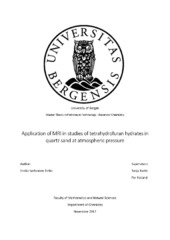Application of MRI in studies of tetrahydrofuran hydrates in quartz sand at atmospheric pressure
Master thesis
Permanent lenke
https://hdl.handle.net/1956/17234Utgivelsesdato
2017-12-06Metadata
Vis full innførselSamlinger
Sammendrag
Natural gas hydrates form under low temperatures and high pressures. They can be found in abundance in permafrost environments and under the sea floor, where the temperature and pressure conditions ensure their stability. The conditions within petroleum transporting pipelines can enter the range of the hydrate stability zone which can result in formation of plugs. The understanding of formation and dissolution of hydrates is crucial for future production of hydrates and for hydrate inhibition within pipelines. At present there are no simple methods for examining hydrates within a porous medium. For further characterization of the formation and dissociation of hydrates within a porous medium, better methods are required. Magnetic resonance imaging (MRI) is applied as a tool for studying hydrates within porous media in this master thesis. The porous media used for this thesis was unconsolidated quartz sand. Magnetic resonance imaging detects the signals sent out by hydrogen nuclei after exposure of radio frequency waves. This technique provides the opportunity to create images from the inside of a porous medium, without cutting it open. The intensity response from hydrogen nuclei within THF hydrate samples has been used to estimate the hydrate saturation of these samples. The estimation of hydrate saturation has been performed both for the total sample and on a local scale simultaneously, by dividing the sample into several slices. The intensity response from the THF hydrate samples was also used to determine formation and dissociation patterns. The T2 relaxation process was studied during the dissociation and reforming of THF hydrates, both on a local scale and for the total sample. The possible effect of wettability preferences of a porous medium on the T2 relaxation process has also been considered.
